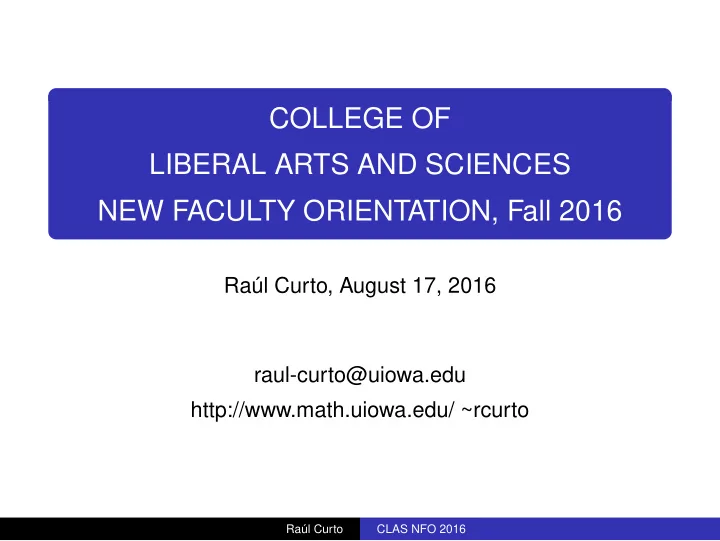

COLLEGE OF LIBERAL ARTS AND SCIENCES NEW FACULTY ORIENTATION, Fall 2016 Raúl Curto, August 17, 2016 raul-curto@uiowa.edu http://www.math.uiowa.edu/ ~rcurto Raúl Curto CLAS NFO 2016
Professional Development Patterns Professional Development Patters Among Pre-tenure Faculty (based on D. Olsen and M.D. Sorcinelli’s article, The pre-tenure years: A longitudinal perspective, New Directions for Teaching and Learning, no. 50, Summer 1992) In 1986, a large public research university began a longitudinal study of one cohort of new faculty, using both the interview and questionnaire formats. Over a five-year period, pre-tenure, faculty members tended to show the following changes. Raúl Curto CLAS NFO 2016
Changes Over Time In Teaching Time spent in teaching preparation declines as the professor becomes more efficient and experienced. Time spent with undergraduates remains fairly constant, while time with graduate students tends to increase. Teaching tends to be a personally satisfying experience for many new faculty and less stressful than establishing a research career or engage in professional development, though some frustrations are normal. Raúl Curto CLAS NFO 2016
Changes Over Time, cont. In Research Time spent on research or professional development steadily increases. Stress about research productivity and support tends to heighten as the tenure review year approaches. In Service Participation in service ideally is quite limited in the first few years, and begins to increase as the tenure/comprehensive review nears. Raúl Curto CLAS NFO 2016
Sources of Stress Common to Pre-tenure Faculty (based on M.D. Sorcinelli’s article, New and Junior Faculty Stress: Research and Responses, New Directions for Teaching and Learning, no. 50, Summer 1992) 1 Not enough time a learning many new things all at once b difficulty balancing teaching and research/professional development c difficulty juggling pressures for publication 2 Inadequate feedback, recognition, and reward a unclear criteria for evaluating research/professional development, teaching and service b inadequate university recognition for contributions c insufficient financial rewards Raúl Curto CLAS NFO 2016
Sources of Stress Common to Pre-tenure Faculty, cont. 3 Lack of clarity regarding tenure/comprehensive review requirements 4 Unrealistic personal expectations (self-imposed pressure to do everything perfectly and all at once) 5 Lack of collegiality in the academic unit, and unrealistic expectations regarding the amount of support that senior faculty will provide 6 Difficulty finding a balance between work and life outside of work Raúl Curto CLAS NFO 2016
Coping Strategies and Characteristics of Successful Faculty 1 Prioritize to identify the value of various projects (determining "crucial" vs. "back burner" projects) 2 Set realistic goals as a first step towards reaching the ideal 3 Use organizing techniques to get control of work time a “to do" lists b appointment books c sequestered work time d using short time periods effectively 4 Know and capitalize on one’s own prime time 5 Find alternative workspace to avoid interruptions for portions of your work Raúl Curto CLAS NFO 2016
Coping Strategies and Characteristics of Successful Faculty, cont. 6 Initiate relaxation exercises to restore energy 7 Change work style to enhance a sense of well-being 8 Cultivate a coping philosophy to overcome pressure 9 Seek social support on and off campus 10 Reward yourself for working hard at a demanding career 11 Seek out advice and social support from a variety of colleagues (including feedback about quality and quantity of activity) (Some people offer much wiser advice than others do, and sometimes excellent advice can be found outside the department) Raúl Curto CLAS NFO 2016
Coping Strategies and Characteristics of Successful Faculty, cont. 12 Establish effective habits of research and writing early in the career (those who don’t, seldom do later in a career) 13 Stay involved in your scholarly/creative community, but avoid whenever possible political fights, turf battles ********************************************************************* The next three slides are borrowed from a February 14, 2013, presentation given at the UI by Kerry Ann Rockquemore, PhD, President, National Center for Faculty Development & Diversity, www.FacultyDiversity.org Raúl Curto CLAS NFO 2016
TENURE-TRACK CHALLENGES The tenure-track is stressful for ALL junior faculty due to: q Varying degrees of preparation for ALL aspects of job q Minimal feedback and support q Unclear criteria for promotion & tenure q Ever-escalating expectations for research and funding q Need to front-load research portfolio q Long probationary period (6 years) followed by a series of high-stakes, yet anonymous votes
“SOLO” CHALLENGES In addition, under-represented faculty commonly describe: q Struggling to find time for research given diversity requests q Experiencing emotional exhaustion from differential classroom dynamics q Managing visibility, invisibility and belonging q Loneliness and lack of collegial acceptance (mentors but not sponsors)
COMMON OUTCOMES All of this can lead to… q A negative impact on productivity (years 1-3) q Engaging in self-isolation as a protective defense mechanism q Emotional exhaustion and anxiety q Stress-related illness q Strained relationships q Thoughts of leaving the academy
Recommend
More recommend